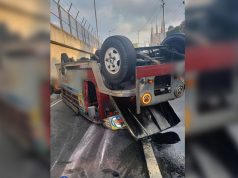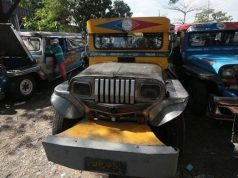Many Filipinos expressed their worries over their transport options following the memorandum of the Commission on Higher Education that requires colleges and universities to implement full in-person classes or hybrid learning next semester.
RELATED: CHED: Online-only learning for colleges, universities no longer allowed next sem
Some are calling on the government to think about alternative transportation of students and educators amid the transport woes and heavy traffic.
“Okay pero sana ayusin naman ang public transport system/heavy traffic. Papasok ka pa lang pagod ka na,” a Facebook user said.
“Kumusta naman traffic at mahal ng pamasahe, ubos oras at allowance ng mga bata. Kung mag-isip kaya kayo ng mas epektibong alternatibo!!!! Ayusin nyo kaya ang sistema!!! Buong mundo, gamit na gamit ang technolohiya, tayo na lang ang backwards!!!!!!!!,” a social media user said.
“Tsaka sana inisip din ng CHED ang mga working students/self supporting students bago nila binaba tong gantong order. Paano sila? Iwan na naman ng sistema, sila na naman mag aadjust? Dapat binibigyan sila ng options di yong gantong parang bara-bara nalang,” she added.
“How about us na working student??? Sobrang lala pa nung transportation here sa Philippines. Please consider us din,” a social media user said.
A study by the insurance technology site GoShorty showed Manila found that Metro Manila is the eighth worst in the world in hours spent in traffic among cities.
RELATED: Manila is the world’s 8th city with longest hours spent in traffic — study
Expensive fare, commodities
Aside from the traffic, many were also concerned over the expensive fare and the rising cost of commodities.
“Naku start nang school full face to face na nga anak ko eh hay, hindi pa nga nakakabangon bungad na agad mga gastos tuition, dorm, foods etc…tapos wala pa subsidy sa college,” a parent said on Facebook.
“Sige po thank you. Pamasahe naman po paki-babaan HAHAHAHAHA” a social media user said.
“Higpit na ng sinturon minimum 200 peso na daily pamasahe pagkain ni anak. Si highschool 50 [pesos] naman. Mahal pa pamasabe at pagkain at bilihin,” a parent lamented.
“Maganda nga po sana kaso po masakit po sa bulsa ang pamasahe at mahal ng bilihin paano naman po yung mga working student,” a Facebook user wrote.
“Pahirap po yan [CHED memorandum] para sa mga lower class na katulad nmin…pataas ng pataas ang pamasahe ngayun,” a social media user said.
“Wala akong issue sa kung ano man ang magiging gusto ng CHED for this upcoming semester, ang issue o problema ko ngayon (mangyaring sa lahat) ay ang mahal na pamasahe. Sana sa darating na taon, maaaksiyonan na ng gobyerno ang problema in terms sa mga presyo ng bilihin lalo na sa gasolina,” a Facebook user said.
“Bukod sa hirap at pagod, ang isa pa sa magiging kalaban namin ay ang mga gagastosin,” she added.
“With the current situation that we have, all in this country is expensive, including essential needs, transport fare, etc. I don’t think F2F classes will be more advantageous to us students, especially those who live outskirts of the city, who attend school in colleges and universities located in Metro Manila, plus dormitories, bedspace is an additional financial expense in every household,” a student said.
RELATED: Electricity, household fuel: Commodities with highest price increase due to inflation
Transportation cost
Last September, the Land Transportation Franchising and Regulatory Board (LTFRB) approved fare increases for modern and traditional public utility jeepneys (PUJ), public utility buses (PUBs), taxis, and transport network vehicle services.
The minimum fare for PUJs increased by P1. With this, a four-kilometer ride costs P12 and P14 for traditional and modern PUJs.
For traditional PUJs, there is an additional P1.80 per kilometer from the previous P1.50.
Meanwhile, passengers riding a modern jeepney have to pay P2.20 per additional kilometer, from the previous P1.80.
For PUBs, the fare for succeeding kilometers increased from P1.85 to P2.25 for ordinary PUBs.
For airconditioned PUBs the fare rose from P2.20 to P2.65, while for provincial PUBs it climbed from P1.55 to P1.90.
Meanwhile, the flag-down rates of taxis and the transport network vehicle services or ride-hailing apps increased by P5.
Transport groups were also seeking an additional fare charge during rush hour.
Traditional and modern PUJs are seeking a P1 surcharge, while PUBs are asking for a P2 additional charge, during rush hour, especially from 5-8 a.m. and 4 to 8 p.m., excluding Sundays and national holidays.
This petition was made before the LTFRB in the wake of the rising fuel prices.
Meanwhile, there is no reported fare increase in Metro Rail Transit-3 and Light Rail Transit Lines 1 and 2 yet.
RELATED: No MRT-3 sale, no fare hike at LRT-2
Early this month, MRT-3 made headlines after its operation was temporarily suspended, delaying trips of commuters coming to work after a long weekend.
RELATED: ‘Sobrang hassle’: Commuters air frustration over ‘delayed’ advisory on MRT-3 glitch
A similar incident also happened in October, which caught the attention of an Asian Development Bank official, calling for “innovation in urban transport.”
RELATED: ADB official calls for transport innovation as commuter queue photo goes viral | ‘Filipinos deserve better’: MRT-3 glitch during rush hour irks commuters










